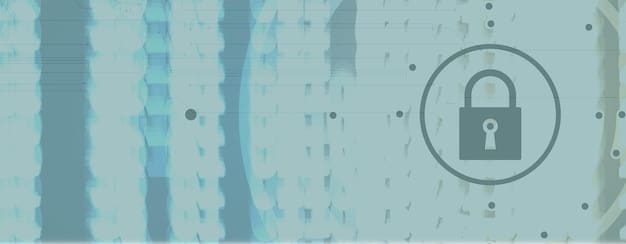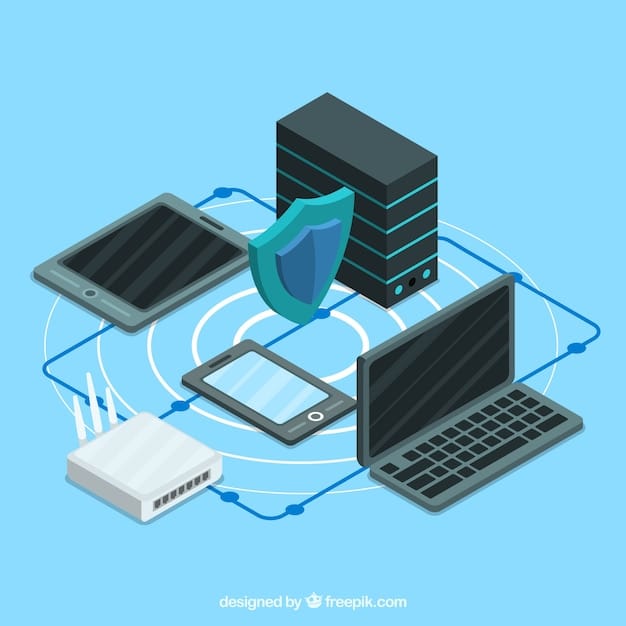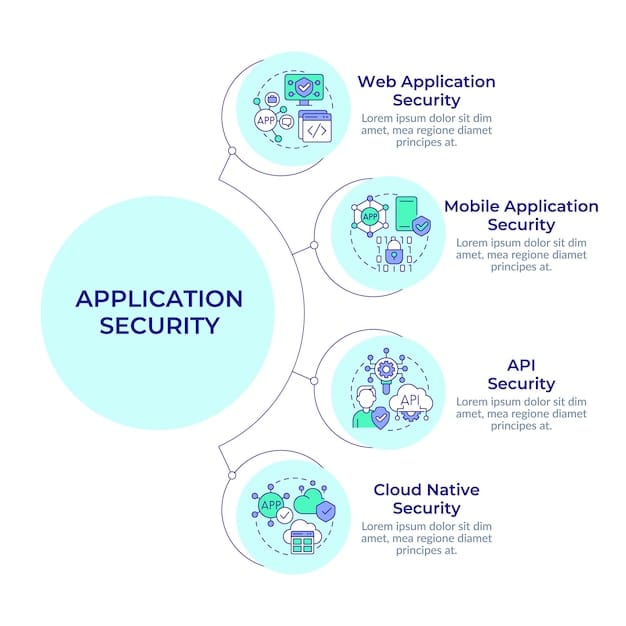Cybersecurity Framework Guide for US Businesses: Protect Your Data

Understanding the Cybersecurity Framework is crucial for US businesses to protect their data and systems by implementing standardized guidelines and best practices to mitigate cyber threats and ensure regulatory compliance.
In today’s digital landscape, understanding the Cybersecurity Framework is essential for US businesses of all sizes. This guide provides a comprehensive overview of cybersecurity frameworks, helping you protect your valuable data and maintain a competitive edge.
What is a Cybersecurity Framework?
A cybersecurity framework is a structured roadmap that provides organizations with a set of guidelines, best practices, and standards to manage and reduce cybersecurity risks effectively. It helps businesses identify vulnerabilities, implement controls, and respond to cyber threats, improving their overall security posture.
Understanding these frameworks is crucial for US businesses aiming to comply with regulations and maintain customer trust.
Key Components of a Cybersecurity Framework
Cybersecurity frameworks typically consist of several core components that work together to provide a holistic approach to security management. These components include:
- Risk Assessment: Identifying potential threats and vulnerabilities to prioritize security efforts.
- Security Policies: Establishing clear guidelines and procedures for employees to follow to maintain security.
- Incident Response Plan: Creating a plan for responding to and recovering from security incidents.
- Continuous Monitoring: Regularly monitoring systems and networks for signs of compromise.
Benefits of Implementing a Cybersecurity Framework
Implementing a cybersecurity framework offers numerous benefits for US businesses. These advantages range from improved security to enhanced compliance. Some key benefits include:
- Reduced Risk: Identifying and mitigating potential threats before they can cause damage.
- Improved Compliance: Meeting regulatory requirements and industry standards more effectively.
- Enhanced Reputation: Building trust with customers and stakeholders by demonstrating a commitment to security.
- Cost Savings: Preventing costly data breaches and security incidents.

By understanding the core components and benefits, businesses can leverage cybersecurity frameworks to establish a robust defense against evolving cyber threats.
Popular Cybersecurity Frameworks for US Businesses
Several cybersecurity frameworks are widely recognized and used by US businesses. Each framework offers a unique approach to security management, catering to different organizational needs and priorities. Understanding these frameworks can help businesses choose the one that best fits their requirements.
Let’s explore some of the most popular options available.
NIST Cybersecurity Framework
The NIST Cybersecurity Framework (CSF) is a widely adopted framework developed by the National Institute of Standards and Technology (NIST). It provides a common language for assessing and improving cybersecurity risk management.
The NIST CSF is structured around five core functions:
- Identify: Develop an organizational understanding to manage cybersecurity risk to systems, assets, data, and capabilities.
- Protect: Develop and implement appropriate safeguards to ensure delivery of critical infrastructure services.
- Detect: Develop and implement appropriate activities to identify the occurrence of a cybersecurity event.
- Respond: Develop and implement appropriate activities to take action regarding a detected cybersecurity incident.
- Recover: Develop and implement appropriate activities to maintain plans for resilience and to restore any capabilities or services that were impaired due to a cybersecurity incident.
CIS Controls
The CIS Controls, formerly known as the SANS Top 20 Critical Security Controls, offer a prioritized set of actions to protect organizations from known cyberattacks. Developed by the Center for Internet Security (CIS), these controls are designed to be practical and actionable.
The CIS Controls are divided into three categories:
- Basic: Foundational controls that every organization should implement.
- Foundational: Controls that provide essential security measures.
- Organizational: Controls that focus on organizational security practices.
ISO 27001
ISO 27001 is an international standard for information security management systems (ISMS). It provides a framework for establishing, implementing, maintaining, and continually improving an ISMS.
Key aspects of ISO 27001 include:
- Risk Management: Identifying and addressing information security risks.
- Policy Development: Creating and implementing security policies and procedures.
- Continuous Improvement: Regularly reviewing and improving the ISMS to adapt to changing threats and business needs.
Each of these frameworks provides a structured approach to cybersecurity, enabling US businesses to mitigate risks, comply with regulations, and protect their valuable assets.
Implementing a Cybersecurity Framework: Step-by-Step
Implementing a cybersecurity framework involves several key steps, from initial assessment to ongoing monitoring and improvement. By following a structured approach, US businesses can effectively establish a robust security posture.
Here’s a comprehensive step-by-step guide:
Step 1: Assess Your Current Security Posture
The first step in implementing a cybersecurity framework is to assess your current security posture. This involves identifying existing security controls, evaluating their effectiveness, and determining gaps in your security defenses.
This assessment should include:
- Vulnerability Scanning: Identifying known vulnerabilities in systems and applications.
- Penetration Testing: Simulating real-world attacks to identify weaknesses in your security defenses.
- Security Audits: Reviewing security policies, procedures, and controls to ensure compliance with industry standards and regulatory requirements.
Step 2: Select the Right Framework
Based on your assessment, select the cybersecurity framework that best aligns with your business needs, industry requirements, and risk tolerance. Consider factors such as the framework’s scope, complexity, and cost.
Different frameworks offer different benefits:
- NIST CSF: Ideal for organizations seeking a comprehensive and flexible framework.
- CIS Controls: Suitable for businesses looking for practical and actionable security controls.
- ISO 27001: Best for organizations aiming to establish an internationally recognized ISMS.
Step 3: Develop a Cybersecurity Plan
Create a detailed cybersecurity plan that outlines the specific actions you will take to implement the chosen framework. This plan should include clear goals, timelines, and responsibilities.
Your cybersecurity plan should address:
- Policy Development: Creating and documenting security policies and procedures.
- Training and Awareness: Educating employees about cybersecurity risks and best practices.
- Technology Implementation: Deploying security technologies to protect systems and data.

By following these steps, US businesses can effectively implement and manage a cybersecurity framework to protect against evolving cyber threats.
Key Cybersecurity Threats Facing US Businesses
US businesses face a wide range of cybersecurity threats that can compromise their data, systems, and reputation. Understanding these threats is crucial for implementing effective security measures.
Here are some of the most prevalent cybersecurity threats:
Phishing Attacks
Phishing attacks are a common method used by cybercriminals to trick individuals into revealing sensitive information, such as usernames, passwords, and credit card details. These attacks often involve sending fraudulent emails or messages that appear to be from legitimate sources.
Protection measures include:
- Employee Training: Educating employees about how to identify and avoid phishing scams.
- Email Filtering: Implementing email security solutions to filter out suspicious messages.
Ransomware
Ransomware is a type of malware that encrypts a victim’s files and demands a ransom payment in exchange for the decryption key. Ransomware attacks can disrupt business operations and result in significant financial losses.
Mitigation strategies include:
- Regular Backups: Regularly backing up critical data to ensure recovery in the event of a ransomware attack.
- Endpoint Protection: Deploying endpoint security solutions to prevent ransomware infections.
Data Breaches
Data breaches involve the unauthorized access, disclosure, or theft of sensitive information. These breaches can result in significant financial losses, reputational damage, and legal liabilities.
Prevention measures include:
- Access Controls: Implementing strict access controls to limit who can access sensitive data.
- Encryption: Encrypting sensitive data both in transit and at rest.
By understanding these key threats and implementing appropriate security measures, US businesses can mitigate the risk of cyberattacks and protect their valuable assets.
The Role of Cybersecurity Insurance
Cybersecurity insurance plays a crucial role in helping US businesses manage the financial risks associated with cyber incidents. While prevention is key, insurance can provide coverage for costs related to data breaches, ransomware attacks, and other cyber events.
Understanding the benefits and limitations of cybersecurity insurance is essential for making informed decisions about your organization’s risk management strategy.
Benefits of Cybersecurity Insurance
Cybersecurity insurance can provide financial protection against a variety of cyber-related losses, including:
- Data Breach Costs: Covering expenses related to notifying affected customers, providing credit monitoring services, and conducting forensic investigations.
- Ransomware Payments: Providing funds to pay ransoms demanded by cybercriminals in ransomware attacks.
- Legal and Regulatory Fines: Covering legal fees and penalties resulting from data breaches and non-compliance with privacy regulations.
Limitations of Cybersecurity Insurance
While cybersecurity insurance can be a valuable tool, it’s important to understand its limitations. Policies may not cover all types of cyber incidents or all associated costs. For example, some policies may exclude coverage for attacks caused by state-sponsored actors or acts of war.
Other limitations may include:
- Exclusions: Specific events or types of losses that are not covered by the policy.
- Coverage Limits: Maximum amounts the insurer will pay for covered losses.
- Deductibles: Amounts the policyholder must pay out-of-pocket before insurance coverage kicks in.
Cybersecurity insurance can be an important component of a comprehensive risk management strategy, helping organizations recover from cyber incidents and minimize financial losses.
Future Trends in Cybersecurity
The cybersecurity landscape is constantly evolving, with new threats and technologies emerging all the time. Staying informed about future trends is essential for US businesses to adapt their security strategies and remain protected.
Here are some key trends to watch:
Artificial Intelligence (AI) in Cybersecurity
AI is increasingly being used in cybersecurity for tasks such as threat detection, incident response, and vulnerability management. AI-powered security tools can analyze large volumes of data to identify suspicious activity and automate security tasks, improving efficiency and effectiveness.
AI applications include:
- Threat Intelligence: Analyzing threat data to identify emerging threats and predict future attacks.
- Behavioral Analysis: Monitoring user and system behavior to detect anomalies that may indicate a security breach.
Cloud Security
As more businesses migrate their operations to the cloud, cloud security is becoming increasingly important. Cloud security involves implementing security measures to protect data, applications, and infrastructure in cloud environments.
Key considerations include:
- Data Encryption: Encrypting data both in transit and at rest to protect against unauthorized access.
- Access Controls: Implementing strict access controls to limit who can access cloud resources.
Zero Trust Security
Zero Trust is a security model based on the principle of “never trust, always verify.” It assumes that all users and devices, both inside and outside the network, are potential threats and must be authenticated and authorized before being granted access to resources.
Elements of Zero Trust include:
- Multi-Factor Authentication (MFA): Requiring users to provide multiple forms of authentication to verify their identity.
- Microsegmentation: Dividing the network into smaller, isolated segments to limit the impact of a security breach.
By staying informed about these trends and adapting their security strategies accordingly, US businesses can better protect themselves against future cyber threats.
| Key Point | Brief Description |
|---|---|
| 🛡️ Frameworks | Structured guidelines for managing cybersecurity risks. |
| ⚠️ Key Threats | Phishing, ransomware, and data breaches can compromise your business. |
| 💰 Insurance | Cybersecurity insurance helps mitigate financial risks from cyber incidents. |
| 🚀 Future Trends | AI, cloud security, and Zero Trust will shape future cybersecurity. |
[FAQ]
▼
The primary goal is to provide a structured set of guidelines and best practices to manage and reduce cybersecurity risks effectively, ensuring data protection.
▼
To protect their data, comply with regulations, build trust with customers, and prevent costly data breaches that can damage their reputation and financial stability.
▼
Main challenges include the complexity of selecting the right framework, allocating resources, and ensuring continuous monitoring and improvement to adapt to evolving threats.
▼
Cybersecurity insurance provides financial protection against data breach costs, ransomware payments, and legal fees, helping businesses recover from cyber incidents more effectively.
▼
Businesses should monitor the use of AI in threat detection, the evolution of cloud security, and the implementation of Zero Trust security models to stay ahead of emerging threats.
Conclusion
Understanding the Cybersecurity Framework is crucial for US businesses to protect their valuable data and systems. By implementing a robust framework, staying informed about key threats, and considering cybersecurity insurance, businesses can effectively navigate the complex cybersecurity landscape and ensure their long-term success.





